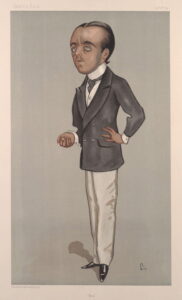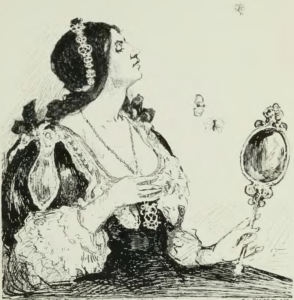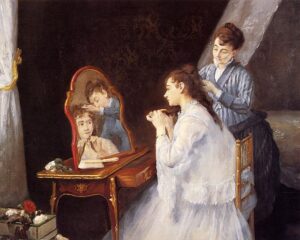Methods of Feminist Persuasion: An Analysis of Max Beerbohms “A Defence of Cosmetics”
INTRODUCTION
Max Beerbohm, being not only an iconic essayist, but also caricature artist, is quite the unique personality in the writing world. He contributed much to the evolution of writing conventions, using his satirical, almost comedic methods in his persuasive pieces. Having inspired famous writers like Virginia Woolf, one may draw the conclusion (based on these relationships) that he was a rather progressive writer himself. In his article for The Yellow Book “A Defence of Cosmetics,” he touches on the subject of the stigmatization of cosmetics, specifically society’s views on the use of cosmetics, and how these standards affect women who use the product themselves.

Because this was written towards the end of the 19th century, he wanted to emphasize the coming of a new era, and therefore the expectation of new societal standards for women. This would mean that cosmetics being poorly judged at the time as a means of deception or disguise, can be seen in a new light. It is evident that, through his satirical approach, as well as his political influence and relations, that Beerbohm’s “A Defence of Cosmetics” uses a feminist lens to encourage woman’s use of cosmetics as art and and a healthy manner of expression.
POLITICAL ALIGNMENT: BEERBOHM’S INFLUENCE ON VIRGINIA WOOLF
Before analyzing his text, it is crucial to establish his political influence in the writing world, specifically how his progessive writing conventions and views affected the outer world. Specifically Virginia Woolf, a famous feminist writer, has many elemnts in her own writing that suggest “Beerbohm’s essays were the standard by which [she] judged her own: he was [evidently] an inspiration and influence” (Davison 353) to her, despite the fact that “critics [would] seldom think of Beerbohm and Woolf in conjunction” (Davison 353). Because Beerbohm had such an influence on the modernist movement (Davison 353), it “gave him the respect of major modernist authors” (Davison 353), including Woolf. She claims him to have an ability to “gesture towards a wider imagined life,” influenced by “the demon of sympathy that now and then compels him into the outset air” (Woolf as qtd in Davison 353). Referring to sympathy as a demon makes it seem as though it is this incessant feeling that Beerbohm can not be rid of. She is suggesting that this demon compels him, which would explain his incessant need to gesture towards this supposed wider imagined life. Woolf’s claim is evident in one of Beerbohm’s lines in “A Defence of Cosmetics’ ‘ when he refers to Artifice (a device of trickery). He portrays the word with personification, artifice now becoming a woman who has been scorned. He claims that “artifice, whom we drove forth, has returned among us, and though her eyes are red with crying, she is smiling forgiveness.” (Beerbohm 82). He views her as a “kind” woman whom the readers should “dance […] a welcome [to]” (Beerbohm 82). His use personification in order to give artifice, an originally stigmatized term in the 18th century, a face and a positive light, in turn is meant to represent women who use cosmetics. Because, in that time, men spit in the face of the trickery of cosmetics, Beerbohm wishes to make it apparent that “the old prejudice is a-dying” (Beerbohm 68). Not only is Beerbohm welcoming a new era (in suggesting the audience dances a welcome to artifice), but also makes her into a women who smiles in forgiveness, who wipes her tears after being hated for her trickery, and welcomes the new era with open arms. It certainly suggests a sympathy that Woolf sees as a benefactor to his work. Him using this character of artifice in order to shed light on this upcoming era is also in direct parallel to what Woolf suggests is his ability to acknowledge a wider imagined life. He uses his unique perspective and conventions to convey these progressive ideas, and because of this, remain as an inspiration to Woolf; this is a relationship that encapsulates his feminist lens, Woolf having been inspired by it in the first place.

BEERBOHM’S SWIFTIAN WIT
One of Beerbohm’s persuasive methods is the use of satire in order to shed light on the sexist standards men have laid on women’s use of cosmetics. One of the foremost pioneers in the genre of satirical persuasion is Jonathon Swift. Swift, in using irony in his texts, manages “to state ironically what would be politically unacceptable if asserted outright” (Bartosynska 637), and, in turn, “unsettle one’s views, leading to the acknowledgment of a different perspective” (Bartosynska 621). This is a method that points the finger of blame directly at the reader, and does so in such a way that forces self reflection upon them. The use of irony that Beerbohm seems to emulate in his text, is extremely similar to that of Swift. “A Defence of Cosmetics” uses the specific ironic features of the mask to get his point across to her audience. The mask is a device in which the narrator is acting in a sort of persona, until they soon reveal themselves to be opposed to said persona (Eilon 27). The persona could be that of a being with an opposing opinion to theirs, which allows the author behind the mask to portray the character based on what they would like the audience to take away from their writing. This is effective in sarcastically declaring that certain notions are in their agreement, until it turns out that, in fact, they are not. It surprises the audience, and further gains their intrigue in order to make the author’s point more likely to be listened to (Eilon 28). Beerbohm uses this method in order to mock the men who hate cosmetics. Although, at first he claims that make up is “a great sign of a more complicated lige.” (Beerbohm 67), he soon reveals his true position, using an impression of the very man he pretends to agree with. He lays claim that “husbands […] who suddenly [realise] that [their] wife was painted, bad her sternly, “go up and take it all off,’ and, on her reappearance, bad her with increasing sternness, ‘go up and put it all on again’ (Beerbohm 67). Yes, he supposedly agrees that cosmetics are a form of lying (a lige), but then he mocks how most men, not recognizing their wives complexion without it, soon wish that the cosmetics were still there. It is a comment on how men condemn women for wearing makeup, but do not like the woman’s natural face. By pretending to agree with the male audience only to reveal that they are thinking irrationally (as shown through his mockery of them), Beerbohm is making use of Swift’s mask. Similar to how Swift unsettles ones views and asserts himself ironically, Beerbohm persuades his audience in the same way, forcing them to take note of their unjust prejudice of cosmetics, and therefore using satire to take a feminist approach on the matter.

HIS SPECIFIC DECLARATIONS
It is worth noting the specific notions in which Beerbohm uses a feminist lens in order to make progressive advancements towards the positive use of makeup. As women grow older in the 19th century “they are criticized for their aging appearance and ridiculed for using cosmetics to hide the signs of aging” (Zadrozny 2). It is evident that, with age, women become harassed by society for their appearance, held up “to harsher aesthetic judgment, largely because of the values placed on youth” (Zadrozny 2). This is an indisputably unjust view, considering for some that “cosmetics consumption is tightly tied with identity construction and the expression of the self” (Jeacle 87). For women to rely on cosmetics to feel accepted in society, and also to feel as if they are expressing themselves, only to be condemned for wearing it, is a prime example of how society places a double standard on women. Beerbohm reiterates this idea, defying the presumptions of a woman’s value based on physical appearance.Through his perspective, the “masks of paint and powder, shadowed with vermeil tinct and most trimley penciled, is woman’s strength” (Beerbohm 68), the womans face meant to represent “a loom round which the beautys artifex may spin the threads of any golden fabric” (Beerbohm 73). Using this image of the spinning of gold fabrics paired with the loom which is meant to represent the face, Beerbohm wishes to represent a woman’s face as the tool for which art can be made (or threads to be spun, in metaphor). He means to demonstrate the artful expression of makeup, as opposed to the supposed deception men claim that it promotes. In addition, he “[suggests] that the prejudice [towards women wearing makeup] was due to the tristful confusion man has made of soul and surface” (Beerbohm 67). Although women may wear make up to present themselves to society, it most definitely does not equate to the their inferiority of the opposite sexe. Men assume that women who wear cosmetics are “moribund [underneath] and [know] it” (Beerbohm 68), but Beerbohm is suggesting that “[one] need not pry into the secret of [cosmetics]. Rather it is a time for […] glad indulgence” (Beerbohm 68). It seems as if men are looking for the answer as to why women wear makeup; they see it as a trick, as a way to deceive men, that they are ugly and withered underneath (moribund), but Beerbohm dismisses this and instead welcomes it as a simple need for self indulgence. Women’s cosmetics do not make them deceptive. Rather, it is simply an artful way of protecting oneself (hence the cosmetics being thought of as a woman’s strength), and also a manner of self expression and enjoyment. It labels cosmetics as a positive means of art, which deflects the malicious stereotypes men plaster onto it. They are not secretly hiding a moribund face, they are simply enjoying a form of artful expression, no hidden intent. This is a very feminist perspective which Beerbohm takes in order to get his point across.

CONCLUSION
It is apparent that the evolution of cosmetics in society has come a long way since Beerbohm’s work. It may seem totally valid to claim that makeup is a form of expression today, but in the late 19th century, Beerbohm’s claims were rather progessive. That is why his methods of ironic persuasion, and assertive claims, as well as political relationships, encompasses just exactly what Beerbohm was working towards; he has encouraged self expression and indulgence, and has done so in a way that asserts the end of an era, and commences not only the beginning of the 20th century, but the acceptance of cosmetics in society. There is still so much more progress to be made, but there is no denying that Beerbohm pushed the phenomenon much further with his piece.
Works Cited
Beerbohm, Max. “A Defence of Cosmetics.” The Yellow Book: An Illustrated Quarterly. Vol. 1. April 1894.
Davison, Sarah. “Catching Mrs Brown: Max Beerbohm’s Influence on Virginia Woolf’s ‘Mr. Bennett and Mrs. Brown’, Notes and Queries, Volume 53, Issue 3, 353-355. September 2006
Eilon, Daniel. “Swift’s Satiric Logic: On Parsimony, Irony, and Antinomian Fiction.” The Yearbook of English Studies, vol. 18, Modern Humanities Research Association, 1988, pp. 18-40.
Jeacle, Ingrid. “Face Facts; Accounting, Feminism and the Business of Beauty.” Critical Perspectives on Accounting. Volume 17, Issue 1, 87-108. 2006.
Katarzyna Bartoszyńska. “Persuasive Ironies: Utopian Readings of Swift and Krasicki.” Comparative Literature Studies, Penn State University Press, 1 December 2013, Vol. 50 (4), pp. 618–642.
Zadrozny, S., (2021) “Of Cosmetic Value Only: Make-Up and Terrible Old Ladies in Victorian Literature.” 19: Interdisciplinary Studies in the Long Nineteenth Century, 32. 2021
